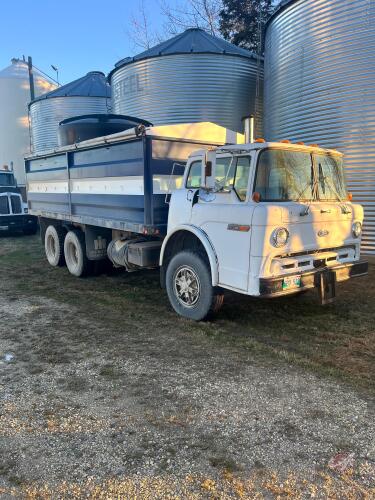Tandem Axle Grain Trucks For Sale: Your Comprehensive Guide to Hauling Success pickup.truckstrend.com
In the agricultural and bulk material transport industries, efficiency and reliability are paramount. For farmers, cooperatives, and transport companies, the ability to move large volumes of grain quickly and safely is critical to profitability. This is where Tandem Axle Grain Trucks For Sale come into play. These robust workhorses are specifically designed to handle the demanding task of hauling heavy loads of grain, feed, and other bulk commodities, offering a crucial balance of capacity, maneuverability, and cost-effectiveness.
Unlike single-axle trucks, tandem axle models feature two rear drive axles, significantly increasing their Gross Vehicle Weight Rating (GVWR) and distributing the load more effectively. This design not only enhances stability and traction, especially on unpaved farm roads, but also allows for larger payloads while complying with legal weight restrictions. Whether you’re upgrading your fleet, starting a new operation, or simply need to move more bushels per trip, understanding the nuances of purchasing a tandem axle grain truck is essential. This guide will equip you with the knowledge needed to make an informed decision and secure the right truck for your needs.
Tandem Axle Grain Trucks For Sale: Your Comprehensive Guide to Hauling Success
Understanding the Anatomy of a Tandem Axle Grain Truck
Before diving into the market, it’s vital to grasp what defines a tandem axle grain truck and its core components. At its heart, it’s a straight truck chassis fitted with a specialized grain body.
- Tandem Axle Configuration: The defining feature is the presence of two closely spaced rear axles, typically both driven (full tandem) or one driven and one non-driven (tag axle). This setup dramatically improves weight distribution, reduces stress on the chassis, and allows for higher legal payloads compared to single-axle trucks.
- The Chassis: This forms the backbone of the truck, housing the engine, transmission, suspension, and steering systems. Common manufacturers include Peterbilt, Kenworth, Freightliner, International, Volvo, and Mack.
- Engine and Drivetrain: Powering these heavy haulers are robust diesel engines (e.g., Cummins, Detroit Diesel, Caterpillar, PACCAR) designed for high torque and durability. Transmissions can be manual (offering greater control and fuel efficiency for experienced drivers) or automatic (easier to drive, especially in stop-and-go situations).
- Grain Body (Box): This is the specialized cargo area.

- Material: Often steel (durable, heavier) or aluminum (lighter, corrosion-resistant, allows for more payload).
- Capacity: Measured in cubic feet or bushels, varying widely based on truck size.
- Hoist System: A hydraulic lift mechanism (front-mount or under-mount) tilts the entire box to unload grain rapidly.
- Tarp System: A roll-over or electric tarp is crucial for protecting the load from weather and preventing spillage during transport.

- Suspension: Heavy-duty air ride or spring suspensions are used to manage the weight and provide a smoother ride, protecting both the truck and its cargo.
- PTO (Power Take-Off): Essential for operating the hydraulic hoist system.

Why Choose a Tandem Axle Grain Truck? Benefits for Your Operation
The choice of a tandem axle grain truck over other transport options offers distinct advantages:
- Increased Payload Capacity: This is the primary benefit. With two rear axles, these trucks can legally carry significantly more weight than single-axle trucks, translating to fewer trips, reduced fuel consumption per bushel, and increased efficiency.
- Enhanced Stability and Traction: The additional axles distribute weight over a larger footprint, improving stability on highways and providing superior traction on soft fields, muddy farm roads, or challenging terrain.
- Better Weight Distribution and Legal Compliance: Properly loaded, tandem axle trucks help you stay within state and federal axle weight limits, avoiding costly fines and ensuring safer operation.
- Versatility in Operations: While primarily used for grain, these trucks can also transport feed, fertilizer, aggregate, or other bulk commodities, making them a versatile asset for diverse agricultural or construction needs.
- Cost-Effectiveness for Local Hauls: For on-farm transport, short-to-medium distance hauls, or shuttle runs to local elevators, a tandem axle grain truck often proves more economical than a semi-truck and trailer combination, which might be overkill for certain operations.
- Maneuverability: Compared to semi-trucks, straight tandem axle trucks are generally easier to maneuver in tight spaces, farmyards, and grain facilities.
Key Considerations When Buying a Tandem Axle Grain Truck
Purchasing a grain truck is a significant investment. Careful consideration of these factors will help you select the right vehicle.
- Payload and GVWR Needs:
- How much grain do you typically need to haul per trip? Match the truck’s capacity to your operational requirements.
- Understand the truck’s Gross Vehicle Weight Rating (GVWR) and Gross Axle Weight Rating (GAWR) to ensure it meets your legal payload requirements in your state or region.
- Engine, Transmission, and Axle Ratio:
- Engine Horsepower and Torque: Consider the terrain and typical loads. More power is needed for hilly areas or very heavy loads.
- Transmission Type: Manual transmissions are often favored for their durability and fuel economy, while automatics offer ease of use.
- Axle Ratio: A higher (numerical) axle ratio provides more torque for hauling heavy loads but reduces top speed and fuel economy on highways. A lower ratio is better for highway driving.
- Grain Body Specifications:
- Material (Steel vs. Aluminum): Aluminum bodies are lighter, allowing for more payload, and are corrosion-resistant, but typically cost more upfront. Steel bodies are more durable for abrasive materials and often cheaper.
- Cubic Capacity: Ensure the body size matches your desired payload.
- Hoist Type: Front-mount hoists are common, but under-mount hoists offer a lower center of gravity.
- Tarp System: Essential for protecting the load. Manual roll-tarp vs. electric options.
- Condition (Especially for Used Trucks):
- Frame and Chassis: Look for cracks, excessive rust, or signs of welding repairs.
- Engine and Transmission: Check for leaks, unusual noises, smoke from the exhaust, and smooth shifting. Ask for maintenance records.
- Brakes: Inspect brake lines, drums/rotors, and pads.
- Tires: Uneven wear can indicate alignment issues or suspension problems.
- Suspension: Check for leaks in air ride systems or broken springs in spring suspensions.
- Hydraulics: Inspect the hoist cylinder, pump, and lines for leaks.
- Cab Interior: While less critical, a well-maintained interior often indicates a truck that has been cared for.
- Maintenance History: A comprehensive service history is invaluable, especially for used trucks. It provides insight into past repairs, oil changes, and preventive maintenance.
- Budget and Financing: Determine your budget range. New trucks offer warranties and the latest technology but come at a premium. Used trucks can be a cost-effective solution but require more diligent inspection. Explore financing options through banks, equipment lenders, or dealership financing.
- Legal and Regulatory Compliance: Research local, state, and federal regulations regarding truck weight limits, licensing, and inspections. Ensure the truck you choose can legally operate where you intend to use it.
Navigating the Market: Where to Find Tandem Axle Grain Trucks For Sale
The market for tandem axle grain trucks is diverse, offering various avenues to find your next vehicle:
- Online Marketplaces: Websites like TruckPaper.com, MachineryTrader.com, BigIron.com, IronPlanet.com, and Ritchie Bros. Auctioneers feature extensive listings from dealers and private sellers across North America. These platforms allow you to filter by make, model, year, price, and location.
- Commercial Truck Dealerships: Both new and used truck dealerships specialize in heavy-duty vehicles. They often offer certified pre-owned options, financing, and after-sales support.
- Farm Equipment Auctions: Local and regional farm auctions frequently feature used grain trucks, often sold directly by farmers. While you can find good deals, "as-is" sales require thorough inspection.
- Local Classifieds and Word-of-Mouth: Don’t underestimate the power of local advertising or networking within your agricultural community. Sometimes the best deals are found close to home.
The Buying Process: Practical Tips for a Successful Purchase
- Define Your Needs Clearly: Before you start looking, know your desired payload, budget, preferred features (e.g., aluminum body, automatic transmission), and any specific regulatory requirements.
- Research Thoroughly: Compare models, features, and pricing from various sources. Read reviews and look for common issues with specific makes/models.
- Inspect Diligently (Especially for Used Trucks):
- Visual Inspection: Look for rust, frame damage, leaks, and tire condition.
- Engine Startup: Listen for unusual noises, check for excessive smoke.
- Test Drive: Pay attention to steering, braking, transmission shifts, and overall ride quality. Drive it loaded if possible.
- Pre-Purchase Inspection (PPI): For used trucks, invest in a professional inspection by an independent, qualified heavy-truck mechanic. This is arguably the most crucial step and can save you thousands in future repairs.
- Verify Documentation: Confirm the title is clear, the VIN matches all documents, and check for any lienholders. Review service records meticulously.
- Negotiate Wisely: Don’t be afraid to negotiate the price, especially for used trucks. Be prepared to walk away if the deal isn’t right.
- Consider After-Sale Support: For new trucks, understand the warranty. For used trucks, consider the availability of parts and service for the chosen make and model.
Common Challenges and Solutions
- Finding the "Perfect" Truck: The ideal combination of age, mileage, features, and price can be elusive. Solution: Prioritize your non-negotiables (e.g., payload capacity) and be flexible on less critical features.
- Hidden Mechanical Issues (Used Trucks): The biggest risk. Solution: Always get a comprehensive pre-purchase inspection by a trusted mechanic. Budget for potential immediate repairs after purchase.
- Financing Hurdles: Securing competitive financing can be challenging for some. Solution: Shop around for lenders, including agricultural banks, credit unions, and equipment finance companies. Have your financial documents in order.
- Regulatory Compliance: Navigating complex weight limits and licensing. Solution: Consult with your state’s Department of Transportation or a trucking consultant to ensure the truck meets all local and federal requirements for your intended use.
Tandem Axle Grain Truck Price Guide
The price of a tandem axle grain truck varies significantly based on its condition, age, mileage, make, model, and specific features (e.g., aluminum body, automatic transmission).
| Category | Age (Years) | Condition | Estimated Price Range (USD) | Key Factors Influencing Price |
|---|---|---|---|---|
| New Truck | 0 | Excellent | $150,000 – $250,000+ | Customization, engine size, transmission type, grain body material/size, warranty. |
| Late Model Used | 1-5 | Very Good | $90,000 – $150,000 | Low mileage, excellent maintenance history, desirable features, minimal wear. |
| Mid-Age Used | 6-10 | Good | $50,000 – $90,000 | Moderate mileage, regular maintenance, minor cosmetic wear, good operational condition. |
| Older Used | 10+ | Fair | $25,000 – $50,000 | High mileage, visible wear and tear, potential need for repairs, may be sold "as-is." |
| Salvage/Parts | Variable | Poor | Under $25,000 | Significant mechanical issues, frame damage, or non-operational. |
Note: These are general estimates and actual prices can fluctuate based on market demand, location, and specific truck configurations.
Frequently Asked Questions (FAQ)
Q1: What’s the typical payload capacity of a tandem axle grain truck?
A1: A typical tandem axle straight grain truck can haul between 500 to 800 bushels of corn or soybeans, or approximately 25,000 to 40,000 pounds of payload, depending on the truck’s GVWR, tare weight, and legal axle weight limits in your region.
Q2: Is a steel or aluminum grain body better?
A2: Aluminum bodies are lighter, allowing for greater payload capacity (more bushels per trip) and are corrosion-resistant. However, they are generally more expensive and can be less durable for hauling abrasive materials like rock. Steel bodies are heavier but more robust and often cheaper upfront. The best choice depends on your specific needs and budget.
Q3: Should I choose an automatic or manual transmission?
A3: Manual transmissions offer greater fuel efficiency and control for experienced drivers, often preferred for long-haul or challenging terrain. Automatic transmissions are easier to operate, reduce driver fatigue, and are excellent for drivers who may not be as comfortable shifting gears, especially in stop-and-go scenarios.
Q4: What are the most important things to look for in a used tandem axle grain truck?
A4: Frame integrity (no cracks or excessive rust), engine health (no excessive smoke, unusual noises, or leaks), transmission performance (smooth shifting, no slipping), brake system condition, tire wear, and a functioning hoist and tarp system. Always prioritize a professional pre-purchase inspection.
Q5: Can I use a grain truck for other commodities besides grain?
A5: Yes, tandem axle grain trucks are versatile and often used for hauling other bulk commodities like feed, fertilizer, sand, gravel, or even some types of aggregate, provided the body material is suitable for the commodity and the weight limits are respected.
Conclusion
Investing in a tandem axle grain truck is a strategic decision that can significantly enhance the efficiency and profitability of your agricultural or transport operation. By offering increased payload capacity, superior stability, and versatility, these trucks are indispensable assets for moving large volumes of commodities.
The market for Tandem Axle Grain Trucks For Sale is broad, ranging from brand-new, fully customized units to dependable used models. The key to a successful purchase lies in thoroughly understanding your specific needs, diligently researching available options, and performing comprehensive inspections. By leveraging the information and practical advice provided in this guide, you are well-equipped to navigate the buying process with confidence, ensuring you acquire a truck that will serve your operations reliably for years to come. Choose wisely, and let your new tandem axle grain truck become a cornerstone of your hauling success.



